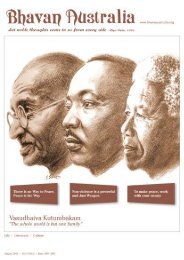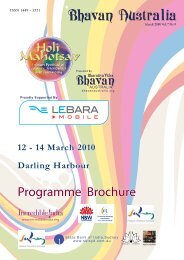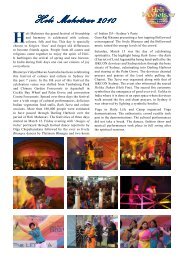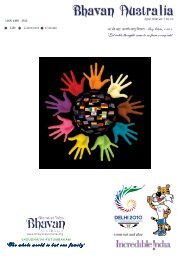Issue 8.5 - Bharatiya Vidya Bhavan Australia
Issue 8.5 - Bharatiya Vidya Bhavan Australia
Issue 8.5 - Bharatiya Vidya Bhavan Australia
Create successful ePaper yourself
Turn your PDF publications into a flip-book with our unique Google optimized e-Paper software.
Freedom Struggle<br />
In 1916, Nehru participated in the Lucknow Session<br />
of the Congress. There, after a very long time,<br />
member of both the extremist and moderate<br />
factions of the Congress party had come. All the<br />
members equivocally agreed to the demand for<br />
“Swaraj” (self rule). Although the means of the two<br />
sections were different, the motive was<br />
“common”—freedom.<br />
In 1921 Nehru was imprisoned for participating in<br />
the first civil disobedience campaign as General<br />
Secretary of the United Provinces Congress<br />
Committee. The life in the jail helped him in<br />
understanding the philosophy followed by Gandhi<br />
and others associated with the movement. He was<br />
moved by Gandhi’s approach of dealing with caste<br />
and “untouchability”. With the passing of every<br />
minute, Nehru was emerging as a popular leader,<br />
particularly in Northern India.<br />
In 1922, some of the prominent members including<br />
his father Motilal Nehru had left the congress and<br />
launched the “Swaraj Party”. The decision upset<br />
Jawahar but he rejected the possibility of leaving<br />
the Congress party. He was also elected as the<br />
President of the Allahabad municipal corporation<br />
in 1920.<br />
Political Life<br />
Jawaharlal Nehru was elected President of the<br />
Allahabad Municipal Corporation in 1924, and<br />
served for two years as the city’s Chief Executive.<br />
This proved to be a valuable administrative<br />
experience for stood him in good stead later on<br />
when he became the prime minister of the country.<br />
He used his tenure to expand public education,<br />
health care and sanitation. He resigned in 1926<br />
citing lack of cooperation from civil servants and<br />
obstruction from British authorities.<br />
From 1926 to 1928, Jawaharlal served as the<br />
General Secretary of the All India Congress<br />
Committee. In 1928-29, the Congress’s annual<br />
session under President Motilal Nehru was held.<br />
During that session Jawaharlal Nehru and Subhas<br />
Chandra Bose backed a call for full political<br />
independence, while Motilal Nehru and others<br />
wanted dominion status within the British Empire.<br />
To resolve the point, Gandhi said that the British<br />
would be given two years to grant India dominion<br />
status. If they did not, the Congress would launch a<br />
national struggle for full, political independence.<br />
Nehru and Bose reduced the time of opportunity to<br />
one year. The British did not respond.<br />
Civil Disobedience Movement<br />
In December 1929, Congress’s annual session was<br />
held in Lahore and Jawaharlal Nehru was elected as<br />
the President of the Congress Party. During those<br />
sessions a resolution demanding India’s<br />
independence was passed and on January 26, 1930<br />
24 | <strong>Bhavan</strong> <strong>Australia</strong> | Nov 2010<br />
in Lahore, Jawaharlal Nehru unfurled free India’s<br />
flag. Gandhiji gave a call for Civil Disobedience<br />
Movement in 1930. The movement was a great<br />
success and forced British Government to<br />
acknowledge the need for major political reforms.<br />
When the British promulgated the Government of<br />
India Act 1935, the Congress Party decided to<br />
contest elections. Nehru stayed out of the<br />
elections, but campaigned vigorously nationwide<br />
for the party. The Congress formed governments in<br />
almost every province, and won the largest number<br />
of seats in the Central Assembly. Nehru was elected<br />
to the Congress presidency in 1936, 1937, and 1946,<br />
and came to occupy a position in the nationalist<br />
movement second only to that of Gandhi.<br />
Jawaharlal Nehru was arrested in 1942 during Quit<br />
India Movement. Released in 1945, he took a<br />
leading part in the negotiations that culminated in<br />
the emergence of the dominions of India and<br />
Pakistan in August 1947.<br />
Prime Minister<br />
In 1947, he became the first Prime Minister of<br />
independent India. He effectively coped with the<br />
formidable challenges of those times: the disorders<br />
and mass exodus of minorities across the new<br />
border with Pakistan, the integration of 500-odd<br />
princely states into the Indian Union, the framing of<br />
a new constitution, and the establishment of the<br />
political and administrative infrastructure for a<br />
parliamentary democracy.<br />
Architect of Modern India<br />
Jawaharlal Nehru played a key role in building<br />
modern India. He set up a Planning Commission,<br />
encouraged development of science and<br />
technology, and launched three successive fiveyear<br />
plans. His policies led to a sizable growth in<br />
agricultural and industrial production. Nehru also<br />
played a major role in developing independent<br />
India’s foreign policy. He called for liquidation of<br />
colonialism in Asia and Africa and along with Tito<br />
and Nasser, was one of the chief architects of the<br />
non-aligned movement. He played a constructive,<br />
mediatory role in bringing the Korean War to an<br />
end and in resolving other international crises,<br />
such as those over the Suez Canal and the Congo,<br />
offering India’s services for conciliation and<br />
international policing. He contributed behind the<br />
scenes toward the solution of several other<br />
explosive issues, such as those of West Berlin,<br />
Austria, and Laos.<br />
Nehru was the chief framer of domestic and<br />
international policies between 1947 and 1964. It<br />
was under Nehru’s supervision that India launched<br />
its first Five-Year Plan in 1951. Nehru’s predominant<br />
roles in substantiating India’s role in the foundation<br />
of institutions like The Non-Aligned Movement<br />
(NAM) had surprised the then stalwarts of<br />
international politics. He advocated the policy of









